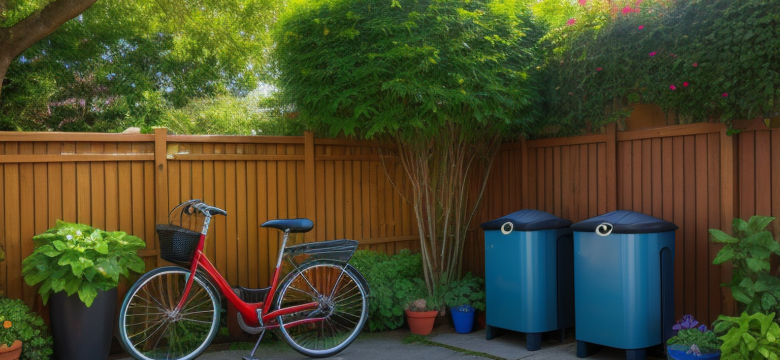Welcome to your journey towards an eco-friendly lifestyle! It’s not just a trend; it’s a necessary shift in how we interact with our planet. Have you ever thought about how your daily choices impact the environment? From the food you eat to the products you buy, every decision counts. Living sustainably means making choices that not only benefit you but also protect our precious Earth. Imagine if everyone made a small change—together, we could create a massive impact!
So, what does it mean to be eco-friendly? At its core, it’s about understanding the principles of sustainability and conservation. It’s like planting a seed; with care and attention, it can grow into something beautiful. By adopting eco-friendly habits, you can reduce your carbon footprint and contribute to a healthier planet. Whether it’s switching to reusable bags or conserving water, every little step matters. Are you ready to dive in and explore practical tips for making sustainable choices that enhance both your life and the environment? Let’s get started!
Understanding Eco-Friendliness
To live an eco-friendly life, it’s essential to grasp what it truly means. Essentially, eco-friendliness revolves around the principles of sustainability and conservation. These principles guide us in making daily choices that not only benefit our own well-being but also protect our planet. Think of it this way: if our planet were a garden, every eco-friendly action is like watering the plants, ensuring they thrive for future generations.
At its core, being eco-friendly means being mindful of the resources we consume and the waste we produce. It encourages us to ask ourselves, “How can I reduce my impact on the environment?” This could involve simple changes, such as:
- Choosing products with minimal packaging
- Opting for reusable items instead of single-use plastics
- Supporting local businesses that prioritise sustainability
By embracing these practices, we not only contribute to a healthier planet but also inspire those around us to do the same. Remember, every small step counts! Together, we can cultivate a culture of eco-friendliness that flourishes and grows, much like a well-tended garden.
Reducing Waste
Reducing waste is not just a trendy phrase; it’s a vital part of living an eco-friendly life. Imagine a world where every item you use has a purpose and isn’t just tossed aside after one use. By adopting a mindful approach to consumption, we can significantly lessen our environmental impact. Start by embracing the three R’s: Reduce, Reuse, and Recycle. Each of these steps plays a crucial role in waste management.
First, think about what you can reduce. This could mean cutting back on single-use plastics, opting for bulk purchases, or simply buying only what you need. For instance, instead of grabbing a plastic bottle of water, consider using a reusable one. Not only does this save money, but it also reduces the amount of plastic waste generated.
Next, reuse items whenever possible. Get creative! Old jars can become storage solutions, while worn-out clothes can be transformed into cleaning rags. By finding new purposes for items, you’re not only saving money but also keeping waste out of landfills.
Finally, recycling is essential. Familiarise yourself with your local recycling guidelines to ensure that you’re disposing of materials correctly. Here’s a quick table to help you remember what can typically be recycled:
| Material | Can be Recycled? |
|---|---|
| Plastic Bottles | Yes |
| Glass Jars | Yes |
| Food Waste | No (but can be composted) |
| Pizza Boxes | No (grease contamination) |
By integrating these practices into your daily routine, you’ll not only contribute to a healthier planet but also inspire others to join the movement. Remember, every little effort counts, and together we can make a significant difference!
Composting Basics
Composting is like giving Mother Nature a little hug! It’s an amazing way to reduce food waste while nourishing the earth. By turning your kitchen scraps and garden waste into rich compost, you’re not just throwing things away; you’re creating a valuable resource that can help your plants thrive. Imagine transforming what would be rubbish into something that can enhance your garden’s soil! It’s a win-win situation.
To start your compost pile, you’ll need to gather a few essentials. First, choose a suitable location in your garden—somewhere that’s easily accessible but not too close to your home. Next, you’ll want to select the right compost bin. There are various options available, from simple open heaps to enclosed bins that can help speed up the composting process. Here’s a quick table to help you decide:
| Compost Bin Type | Pros | Cons |
|---|---|---|
| Open Heap | Easy to set up, good aeration | Can attract pests, less tidy |
| Enclosed Bin | Neat appearance, reduces pests | More expensive, may need turning |
| Worm Bin | Great for small spaces, produces worm tea | Requires maintenance, not for all food scraps |
Once you’ve chosen your bin, it’s crucial to know what to compost. You can add items like fruit and vegetable scraps, coffee grounds, and even lawn clippings. However, avoid meat, dairy, and oily foods, as these can attract unwanted critters. By understanding what goes into your compost, you’ll be well on your way to creating a nutrient-rich soil amendment that benefits your garden and the environment.
Choosing the Right Bin
When it comes to composting, can make all the difference in your eco-friendly journey. Think of it as selecting the perfect home for your organic waste; it needs to be comfortable, functional, and suited to your space. There are several options available, and each has its unique advantages. For instance, if you have a small garden or limited outdoor space, a compost tumbler might be ideal. These bins are compact and allow for easy mixing, which accelerates the composting process.
On the other hand, if you have more room, a traditional compost bin could be the way to go. These bins can hold larger quantities of waste and are often more cost-effective. However, they do require a bit more effort in terms of turning the compost to aerate it.
Here’s a quick comparison of popular compost bin types:
| Type of Bin | Best For | Pros | Cons |
|---|---|---|---|
| Compost Tumbler | Small spaces | Easy to mix, quick composting | Limited capacity |
| Traditional Bin | Large gardens | High capacity, cost-effective | Requires manual turning |
| Worm Bin | Indoors | Odourless, great for small spaces | Requires maintenance and care |
Ultimately, the right bin for you will depend on your available space, the volume of waste you produce, and how hands-on you want to be in the composting process. Remember, the goal is to create a thriving environment for your compost, so choose wisely!
What to Compost
Composting is a fantastic way to reduce waste and enrich your garden soil, but knowing what to compost can be a bit tricky. Think of your compost pile as a mini ecosystem where organic materials break down into nutrient-rich compost. To get started, you’ll want to include a mix of green materials and brown materials. Green materials are rich in nitrogen and include items like:
- Fruit and vegetable scraps
- Grass clippings
- Coffee grounds and filters
- Eggshells
On the other hand, brown materials provide carbon and include:
- Dried leaves
- Cardboard and paper
- Wood chips
- Sawdust
It’s essential to avoid composting certain items that can attract pests or create unpleasant odours. Steer clear of:
- Meat and dairy products
- Oils and fats
- Pet waste
- Diseased plants
By understanding what to compost, you can create a thriving compost pile that not only reduces waste but also benefits your garden immensely. Remember, the key is balance; a good mix of greens and browns will lead to a successful composting experience!
Eco-Friendly Shopping
Shopping sustainably is not just a trend; it’s a lifestyle choice that can significantly reduce your carbon footprint and contribute to a healthier planet. Imagine walking into a store where every product you see has been made with care for the Earth — that’s the kind of shopping we should strive for!
To start your eco-friendly shopping journey, consider these practical tips: always opt for local products whenever possible. Not only does this support your community, but it also cuts down on the emissions associated with transporting goods over long distances. Additionally, look for items that are made from recycled materials or are biodegradable, as these choices help reduce waste.
Furthermore, be mindful of packaging. Products with minimal or compostable packaging are ideal. You might also want to bring your own reusable bags to avoid single-use plastics. Remember, every small change counts!
Here’s a quick table to help you choose wisely:
| Eco-Friendly Choices | Impact |
|---|---|
| Local Produce | Supports local economy, reduces transport emissions |
| Recycled Products | Reduces waste and conserves natural resources |
| Biodegradable Items | Break down naturally, reducing landfill waste |
By making conscious decisions while shopping, you not only enhance your lifestyle but also inspire others to follow suit. So, next time you hit the shops, think about the impact of your choices — it’s a simple step towards a more sustainable future!
Energy Conservation
Conserving energy is not just a trendy buzzword; it’s a vital practice for anyone looking to live an eco-friendly lifestyle. Think of energy conservation as a way to give back to the planet while also saving some cash. By making small adjustments in our daily routines, we can significantly reduce our energy consumption. Have you ever considered how turning off lights when you leave a room or unplugging devices that aren’t in use can make a difference? It may seem trivial, but these actions accumulate over time, leading to a substantial reduction in energy use.
Moreover, adopting energy-efficient appliances can be a game-changer. These devices are designed to use less electricity, which not only helps the environment but also lowers your utility bills. For example, replacing old incandescent bulbs with LED lights can cut your lighting energy costs by up to 80%. If you’re curious about how your home stacks up in terms of energy efficiency, consider conducting a home energy audit. This assessment can identify areas where you can improve and save.
Additionally, integrating smart home devices can elevate your energy-saving efforts. These gadgets allow you to monitor and control your energy usage from your smartphone, making it easier to stay on track. Imagine adjusting your thermostat remotely or setting your appliances to run during off-peak hours. It’s like having a personal energy manager right in your pocket!
In summary, energy conservation is about being mindful of how we use resources. By embracing these simple yet effective strategies, we can contribute to a healthier planet while enjoying the benefits of lower energy costs. So, why not start today? Every little bit helps!
Smart Home Devices
In our quest for an eco-friendly lifestyle, smart home devices can be game changers. Imagine having the ability to monitor and control your energy usage right from your smartphone! These devices not only make life more convenient but also contribute to significant energy savings. For instance, smart thermostats can learn your heating and cooling preferences, adjusting temperatures automatically to reduce energy waste when you’re not at home.
But that’s just the tip of the iceberg. Consider smart lighting systems, which allow you to switch off lights remotely or set schedules to ensure they’re only on when needed. This can lead to a noticeable drop in your electricity bill. Here’s a quick overview of some popular smart home devices that can enhance your energy efficiency:
| Device | Benefit |
|---|---|
| Smart Thermostat | Automatically adjusts temperature for energy savings. |
| Smart Lights | Control lighting remotely and set schedules. |
| Smart Plugs | Monitor energy usage of plugged-in devices. |
| Smart Sensors | Detect motion and adjust lighting accordingly. |
By investing in these technologies, you’re not just upgrading your home; you’re also making a positive impact on the environment. So, why not take the plunge? With smart home devices, you can live comfortably while being a champion for sustainability!
Renewable Energy Sources
Switching to is like giving the planet a much-needed breath of fresh air! Imagine harnessing the power of the sun, wind, and water to fuel our daily lives without depleting the Earth’s resources. It’s not just a dream; it’s a reality that can be achieved with a few conscious choices. By embracing renewable energy, we can significantly reduce our carbon footprint and contribute to a more sustainable future.
There are several popular renewable energy sources that you might consider:
- Solar Energy: This harnesses sunlight using photovoltaic cells, which can be installed on rooftops or in solar farms. It’s a fantastic way to power your home while reducing reliance on fossil fuels.
- Wind Energy: Wind turbines capture the kinetic energy of wind and convert it into electricity. Just think of those majestic turbines spinning on a hilltop!
- Hydropower: Utilizing flowing water, such as rivers and streams, hydropower generates electricity through turbines. It’s one of the oldest forms of renewable energy.
Each of these sources has its own unique benefits, and the best part? They are sustainable, meaning they won’t run out as long as we take care of our planet. By considering these options, you can not only save money on energy bills but also make a significant impact on reducing greenhouse gas emissions. So, why not take the plunge into a greener lifestyle? Your planet will thank you!
Mindful Transportation
Transportation choices play a significant role in our ecological footprint. Every time you step out, you have the power to make a decision that impacts the environment. Are you hopping into your car for a short trip, or could you take a moment to consider a more sustainable option? By embracing , you can not only reduce your carbon emissions but also contribute to a healthier planet.
Walking and cycling are fantastic ways to get around while keeping fit and reducing your environmental impact. Imagine the fresh air filling your lungs as you pedal through the park, surrounded by nature. It’s a win-win! For longer distances, public transport is an excellent alternative. Buses and trains can carry many passengers at once, significantly cutting down on the number of vehicles on the road. In fact, using public transport can reduce your carbon footprint by up to 45% compared to driving alone.
Moreover, if you do need to drive, consider options like carpooling or ride-sharing. Not only do these methods lower emissions, but they also save you money on fuel and parking. Think of it as sharing the ride and the responsibility! It’s a community effort that fosters connections and reduces traffic congestion. In a world where every little bit counts, making these small changes can lead to a big impact.
So, the next time you’re planning your journey, ask yourself: is there a greener way to get there? By making mindful transportation choices, you’re not just getting from A to B; you’re actively participating in the fight against climate change, one ride at a time.
Benefits of Public Transport
Using public transport is not just about getting from point A to point B; it’s a fantastic way to make a positive impact on our planet! Imagine hopping onto a bus or train and knowing that you’re contributing to a cleaner environment. Public transport significantly reduces your carbon footprint compared to driving a personal vehicle. Each bus can replace dozens of cars on the road, which means less traffic congestion, cleaner air, and a happier planet.
Moreover, public transport can save you money! Think about it: no more hefty fuel bills, parking fees, or maintenance costs. Instead, you can invest that money in experiences or eco-friendly products. And let’s not forget the social aspect! Riding the bus or train gives you the chance to connect with your community, meet new people, and share stories. It’s like being part of a moving neighbourhood!
Here are some key benefits of using public transport:
- Environmental Impact: Lower greenhouse gas emissions.
- Cost-Effective: Saves money on fuel and maintenance.
- Convenience: Reduces the stress of driving and finding parking.
- Community Building: Encourages social interaction and a sense of belonging.
In a nutshell, opting for public transport not only benefits you but also contributes to a sustainable future. So, next time you need to travel, consider leaving the car at home and embracing the bus or train. Your wallet and the Earth will thank you!
Carpooling and Ride-Sharing
Have you ever thought about how many empty seats are in cars during your daily commute? Carpooling and ride-sharing are not just trendy buzzwords; they are practical solutions to a pressing problem. By sharing rides, you can significantly reduce your carbon footprint, save money on fuel, and ease the burden of traffic congestion. Imagine the roads less crowded and the air cleaner!
When you opt for carpooling, you’re not just helping the environment; you’re also building a sense of community. Sharing a ride with colleagues or neighbours can turn a mundane journey into a social outing. Plus, it’s a great way to meet new people and strengthen existing relationships. Think of it as turning your commute into a mini road trip!
With the rise of technology, finding a carpool buddy has never been easier. Numerous apps and platforms connect drivers with passengers, making it simple to coordinate schedules. Here are some benefits of carpooling and ride-sharing:
- Cost-Effective: Share fuel costs and reduce wear and tear on your vehicle.
- Environmental Impact: Fewer cars on the road mean lower emissions.
- Convenience: Use carpool lanes for quicker travel times.
Incorporating carpooling into your routine is straightforward. Start by chatting with friends or co-workers about shared rides. You’ll be surprised at how many people are eager to join in. So, why not give it a go? Together, we can make a difference, one ride at a time!
Building a Sustainable Community
Creating a sustainable community isn’t just a personal journey; it’s a collective effort that can lead to **significant changes** in our environment and lifestyle. When individuals come together, they can amplify their impact, turning small actions into a **powerful movement**. Have you ever thought about how much more we can achieve as a group? By engaging with local initiatives and supporting one another, we can foster a culture of sustainability that benefits everyone.
One way to start is by joining local eco-groups. These groups often provide resources, education, and support for those looking to live more sustainably. They can be a fantastic way to meet like-minded individuals who share your passion for the planet. Imagine attending workshops that teach you about composting, or participating in community clean-up days. The connections you make can lead to lasting friendships and a stronger commitment to your eco-friendly goals.
Participating in community events is another excellent avenue to promote eco-awareness. From tree planting days to local farmers’ markets, these gatherings not only enhance your knowledge but also strengthen community ties. Here’s a quick overview of the types of events you might find:
| Event Type | Description |
|---|---|
| Clean-Up Drives | Organised efforts to clean local parks, rivers, or neighbourhoods. |
| Workshops | Educational sessions on topics like recycling, gardening, and energy conservation. |
| Farmers’ Markets | Supporting local produce and reducing carbon footprints by buying locally. |
In conclusion, building a sustainable community is about **connection** and **collaboration**. By joining forces, we can create a ripple effect, inspiring others to take action and make sustainable choices. So, why not take that first step today? Your community is waiting for you!
Joining Local Eco-Groups
Joining local eco-groups is a fantastic way to enhance your journey towards an eco-friendly lifestyle. These communities not only provide invaluable resources and knowledge but also create a supportive environment where like-minded individuals can share experiences and tips. Imagine walking into a room filled with passionate people who are just as eager as you are to make a difference—it’s energising!
By participating in these groups, you can engage in various activities that promote sustainability. From community clean-ups to tree planting events, the opportunities to contribute are endless. These activities not only help the environment but also foster a sense of camaraderie and community spirit. Plus, you might discover local initiatives you never knew existed!
Here are some benefits of joining local eco-groups:
- Networking: Meet new friends who share your passion for the planet.
- Education: Gain access to workshops and resources that deepen your understanding of eco-friendly practices.
- Impact: Work together on projects that have a tangible effect on your local environment.
To find these groups, consider checking community boards, social media platforms, or local environmental organisations. Remember, every small step counts, and by joining a local eco-group, you’re not just changing your habits; you’re becoming part of a larger movement towards sustainability.
Participating in Community Events
Getting involved in community events is a fantastic way to embrace an eco-friendly lifestyle while also connecting with like-minded individuals. Imagine a vibrant gathering where everyone is passionate about making a difference—sounds invigorating, right? By participating, you not only contribute to local sustainability efforts but also gain valuable knowledge and resources that can enhance your own eco-journey.
Community events can range from clean-up drives at local parks to workshops on sustainable gardening. These activities offer a perfect opportunity to learn from experts and share experiences with fellow eco-warriors. Plus, they often create a sense of camaraderie and collective purpose. Here are some examples of events you might consider:
- Tree Planting Days: Help restore local green spaces by planting trees, which are vital for our planet.
- Recycling Drives: Participate in initiatives that promote recycling and educate others on proper waste management.
- Farmers’ Markets: Engage with local farmers and vendors, supporting sustainable agriculture and enjoying fresh produce.
Moreover, many communities host eco-fairs and workshops that focus on various aspects of sustainability, from energy conservation to waste reduction. Not only do these events provide practical tips, but they also foster a sense of belonging and shared responsibility. So, why not step out of your comfort zone and join the movement? Your participation could spark change and inspire others to follow suit!
Frequently Asked Questions
- What does it mean to live an eco-friendly life?
Living an eco-friendly life means making choices that are sustainable and reduce harm to the environment. It involves understanding the impact of your actions, from the products you buy to the way you travel.
- How can I reduce waste in my daily life?
You can reduce waste by following the three R’s: Reduce, Reuse, and Recycle. Start by minimising single-use items, repurposing what you can, and properly recycling materials like paper and plastics.
- What are the benefits of composting?
Composting helps divert organic waste from landfills, reduces greenhouse gas emissions, and creates nutrient-rich soil for gardening. It’s a simple yet effective way to contribute to a healthier planet.
- How can I shop sustainably?
To shop sustainably, look for local products, choose items with minimal packaging, and support brands that prioritise ethical practices. Your purchasing power can drive positive change!
- What are some eco-friendly transportation options?
Consider walking, cycling, or using public transport to reduce your carbon footprint. Carpooling and ride-sharing are also great ways to cut down on emissions while saving money.





